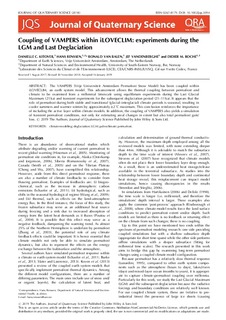| dc.contributor.author | Kitover, Danielle C | |
| dc.contributor.author | Renssen, Hans | |
| dc.contributor.author | van Balen, Ronald | |
| dc.contributor.author | Vandenberghe, Jef | |
| dc.contributor.author | Roche, Didier M. | |
| dc.date.accessioned | 2020-01-29T09:53:10Z | |
| dc.date.available | 2020-01-29T09:53:10Z | |
| dc.date.created | 2019-07-04T14:19:55Z | |
| dc.date.issued | 2019 | |
| dc.identifier.citation | Journal of Quaternary Science. 2019, 34 (3), 215-227. | nb_NO |
| dc.identifier.issn | 0267-8179 | |
| dc.identifier.uri | http://hdl.handle.net/11250/2638514 | |
| dc.description | This is an open access article under the terms of the Creative Commons Attribution‐NonCommercial‐NoDerivs License, which permits use and distribution in any medium, provided the original work is properly cited, the use is non‐commercial and no modifications or adaptations are made. | nb_NO |
| dc.description.abstract | The VAMPERS (Vrije Universiteit Amsterdam Permafrost Snow Model) has been coupled within iLOVECLIM, an earth system model. This advancement allows the thermal coupling between permafrost and climate to be examined from a millennial timescale using equilibrium experiments during the Last Glacial Maximum (21 ka) and transient experiments for the subsequent deglaciation period (21–11 ka). It appears that the role of permafrost during both stable and transitional (glacial–interglacial) climate periods is seasonal, resulting in cooler summers and warmer winters by approximately ±2 °C maximum. This conclusion reinforces the importance of including the active layer within climate models. In addition, the coupling of VAMPERS also yields a simulation of transient permafrost conditions, not only for estimating areal changes in extent but also total permafrost gain/loss. | nb_NO |
| dc.language.iso | eng | nb_NO |
| dc.rights | Attribution-NonCommercial-NoDerivatives 4.0 Internasjonal | * |
| dc.rights.uri | http://creativecommons.org/licenses/by-nc-nd/4.0/deed.no | * |
| dc.title | Coupling of VAMPERS within iLOVECLIM: experiments during the LGM and Last Deglaciation | nb_NO |
| dc.type | Journal article | nb_NO |
| dc.type | Peer reviewed | nb_NO |
| dc.description.version | publishedVersion | nb_NO |
| dc.rights.holder | (c) 2019 The Authors. | nb_NO |
| dc.source.pagenumber | 215-227 | nb_NO |
| dc.source.volume | 34 | nb_NO |
| dc.source.journal | Journal of Quaternary Science | nb_NO |
| dc.source.issue | 3 | nb_NO |
| dc.identifier.doi | 10.1002/jqs.3094 | |
| dc.identifier.cristin | 1710159 | |
| cristin.unitcode | 222,58,1,0 | |
| cristin.unitname | Institutt for natur, helse og miljø | |
| cristin.ispublished | true | |
| cristin.fulltext | original | |
| cristin.qualitycode | 2 | |

